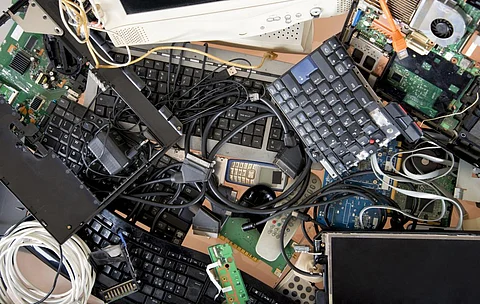

Consumers fail to recognise almost one-sixth of electronic waste generated globally, amounting to nearly 9 billion kilogrammes per year, a new study has found. These items dubbed as “invisible e-waste” include cables, e-toys, e-cigarettes, e-bikes, power tools, smoke detectors, USB sticks, wearable health devices and smart home gadgets.
Brussels-based organisation Waste Electrical and Electronic Equipment (WEEE) Forum organises International E-Waste Day on October 14 every year. It commissioned the United Nations Institute for Training and Research (UNITAR) to calculate the annual quantities of “invisible” e-waste items in millions of kgs, in millions of pieces, and in kg and pieces per capita.
The study findings were published on WEEE website on October 12, 2023, two days ahead of the occasion to focus on “invisible e-waste” this year.
The term “invisible e-waste” refers to e- waste that goes unnoticed due to its nature or appearance, leading consumers to overlook its recyclable potential, the study said.
The total amount of e-waste generated in 2022, according to the global e-waste monitor 2020, is 59.4 billion kg, the study findings stated. The share is approximately 15 per cent on the basis of weight, it added.
Invisible e-waste generated
inh = inhabitants. E-waste generated of selected UNU-KEY categories related to invisible e-waste in 2022 (from dataset of the 2020 global e-waste monitor, UNITAR). Source: CP Balde, T Yamamoto, V Forti, UNITAR, Statistical briefing on invisible e-waste for International E-waste Day 2023, 2023, Bonn. ^ contains double counting with above categories.
*Note: The UNITAR figures above represent an estimate, and UNU-KEY categories cover larger categories like ‘small IT’ where some of the items are ‘invisible’ (like USB sticks) and some others are easy to recognise as e-waste, for example, a keyboard).
The study highlighted the value of raw materials in the global e-waste generated — amounting to an estimated $57 billion in 2019. Most of that is attributed to iron, copper and gold components, it found. Of the total, a sixth or $9.5 billion in material value each year is in the invisible e-waste category, the research stated.
Other examples of common, invisible e-waste items in households, it found, include toothbrushes, shavers, external drives and accessories, headphones and earbuds, remote controls, speakers, LED lights, power tools, household medical equipment, heat and smoke detectors, etc.
“People tend to recognise household electrical products as those they plug in and use regularly. But many people are confused about the waste category into which ancillary, peripheral, specialist, hobby, and leisure products fit and how to have them recycled,” director-general of the WEEE Forum Pascal Leroy was quoted as saying in the report.
“Many people don’t recognise some battery-powered or wired-in products like a smoke detector or smart thermostat as an electrical product because they don't have a plug. They are also unaware of the hazardous components e-waste contains. If not properly treated, substances like lead, mercury or cadmium can leach into and contaminate the soil and water,” Leroy added.
Some of the figures highlighted by the study are:
Much of this e-waste is stored in homes, perhaps put aside for potential future use, the study said.
“Many people don’t realise this waste could be recycled — a huge sleeping resource at a time when demand for copper is forecast to rise six-fold by 2030 in Europe alone. This, to meet the needs of strategic sectors such as renewable energy, electric mobility, industry, communications, aerospace and defense,” further found the study.
In light of these findings, WEEE Forum asked everybody to get their e-waste to the appropriate municipal collection facility.
“Sadly, invisible e-waste often falls under the recycling radar of those disposing of them because they are not seen as e-waste. We need to change that and raising awareness is a large part of the answer. Much effort and progress was made around plastic pollution and people are now more conscious about it, especially with a United Nations treaty on plastics in the works by 2024. We hope the same will occur in the e-waste field,” Magdalena Charytanowicz of WEEE Forum was quoted as saying.
“In Europe, thanks to 20 years of Extended Producer Responsibility (EPR) legislation, 55 per cent of e-waste generated is now officially collected and reported. Still, according to the UN global e-waste monitor, other parts of the world show much slower growth rates in its collection, and globally, the reported average collection rate is just over 17 per cent,” reads a statement in the report.
Virginijus Sinkevičius, European Commissioner for the Environment stated in the report that this International e-waste Day, the European Union acknowledges the pressing e-waste challenge and is proactively setting a leadership example.
“The ongoing expansion in electronic device production and consumption has significant environmental and climate repercussions. Introducing EPR in e-waste legislation two decades,” he said.
The European Commission considers lithium a ‘strategic raw material’ crucial to Europe’s economy and green energy transition, but supplies are at risk. Most of these materials are thrown away in household bins and elsewhere, the study findings highlighted.
According to the UN, eight kg of e-waste per person will be produced worldwide in 2023. “Only 17.4 per cent of this waste, containing harmful substances and precious materials, will be recorded as properly collected, treated, and recycled globally,” the WEEE stated.
The remaining tens of millions of tonnes, as per it, will be placed in landfills, burned, illegally traded, improperly treated, or hoarded in households.
“Even in Europe, which leads the world in e-waste recycling, only 55 per centof e-waste is officially reported as properly collected and recycled and the lack of public awareness is among the factors preventing countries from developing circular economies for electronic equipment,” it added.